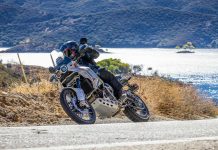Let’s clear the confusion immediately about Yamaha’s all-new YZF-R7. The R7 is not a direct replacement for the YZF-R6 track-ready machine. The R6 is vacant from the 2022 street lineup, and only available as a track bike. Yamaha confirms that the YZF-R7 isn’t designed to be a traditional 600-class supersport bike. However, the 2022 Yamaha YZF-R7 sits in the same spot in the YZF family that the R6 did, filling the gap between the beginner-friendly YZF-R3 and the YZF-R1 superbikes. So, yes, it does replace the R6, though it plays a different role.
Let’s get to the Fast Facts from our first ride review of the new R7 at the private Atlanta Motorsports Park, a two-mile circuit designed by Formula One track architect Hermann Tilke that features 16 turns and 98 feet of elevation changes.
- The 2022 Yamaha YZF-R7 is not related to the iconic 1999 Yamaha YZF-R7 (OW-02). That inline-4 powered motorcycle was built to satisfy race homologation needs for Yamaha’s World Superbike Team—only 500 were produced in its one-year run. Yamaha’s stateside staff who designed the bike says the YZF-R7 name was focused on representing a new generation of supersport and “not reference anything from the past.”
- As you likely know by now, the 2022 Yamaha YZF-R7 borrows the CP2 parallel-twin engine used in three other Yamaha models—the MT-07, XSR700, and Ténéré 700. The 2022 Yamaha R7’s DOHC 689cc engine provides a broad torque across the rpm range that pulls strongly out of corners and revs quickly to just above 9000 rpm. That’s where I shifted most of the day. The power delivery is linear, with a good feel thanks to the crossplane crankshaft design.
- I shifted smoothly throughout the day due to the six-speed transmission that was certainly tweaked over the previous model-year MT-07s. Many riders complained of sloppy shifting transitions in the lower gears on the 2020 and earlier models, but the transmission on the 2022 R7 is buttery smooth. Helping this is the new assist-and-slipper clutch that reduces clutch load by 20 percent—a first for a CP2 engine.
- The optional Yamaha Parts & Accessories GYTR Quick Shifter Kit ($200) was also included on my test bike. It tells the ECU to alter the engine speed while upshifting. This is a must-have addition due to its usefulness with clicking through the gears when accelerating at top rpm. Inexplicably in 2022, it’s only for clutchless upshifts, not downshifts—something I was reminded of often during the first few laps. The assist function makes the clutch pull extremely light, and I used my left index finger for downshifting most of the day.
- To keep the price point low, the 2022 Yamaha YZF-R7 features minimal electronics except for ABS. The CP2 engine’s character doesn’t require traction control or riding modes. The only time I lost rear-wheel traction was when the tire was fried. The engine’s single riding mode delivers a soft enough throttle input to keep experienced riders safe under wet conditions (with good rubber, of course).
- The R7 borrows its basic chassis from the MT-07, but with all-new geometry. The R7’s setup provides more agility and ease of turning than the MT-07, despite being clothed in supersport bodywork.
- You can ride the 2022 R7 all day at the track or street with pure laziness. The chassis responds to the laziest of inputs with ease and recovers quickly from the harshest transitions from full throttle to full brake. This is due to the following geometer modifications compared to the MT-07 (and R6, for perspective):
-
- The wheelbase is 0.2 inches shorter than the MT-07 (0.8 inches longer than the R6)
- The rake is 1.2 degrees steeper than the MT-07 (0.3 degrees steeper than the R6)
- The R7 and MT-07 share the same trail at 3.5 inches (0.2 inches shorter than the R6)
- The almost-fully adjustable KYB suspension provided feel throughout the day. Knowing the target audience is sport-forward and will use the R7 on twisty roads and racetracks, Yamaha included a 41mm KYB fork that is fully adjustable. I bottomed the forks a few times under hard braking into turn one, where a few bumps are present on the perfect line. I added more spring preload after my second session, as I didn’t like soft feel up front, but left all else as set from the factory. The rear KYB shock is adjustable for spring preload and rebound damping only—no compression damping settings. I had zero issues with the rear shock. Yamaha engineers positioned the rear suspension link mount position to raise the rear of the chassis to my liking.
- The Brembo/ADVICS/Nissin brake combination provided more than enough braking power. The R7 doesn’t get the giant 320mm front discs found on the outgoing R6, but the 298mm rotors did their job well. This is also the first Yamaha to use a Brembo radial master cylinder (16mm piston) for the front calipers. I was able to slow and guide the R7 while trail braking through each of the 16 corners at Atlanta Motorsports Park. The brakes never faded, and the feel at the lever allowed precise input to moderate slowing. The rear disc is 245mm, up 25mm over the R6, and responded well to input when tightening the line at WOT on the final long left-hander. ABS is standard and not switchable. I felt the ABS intervene only at the end of the faster straights.
- The choice of Bridgestone Battlax Hypersport S22 tires clearly targets the street supersport rider. However, my test R7 was fitted with track-only Bridgestone Racing R11 tires—we were on a closed course, after all. The R11 rubber remained sticky all day. Because the R7 weighs only 414 pounds wet—up eight pounds over the MT-07—the S22s are a wise choice for longevity and stickiness on the street. I tested the S22 tires at Jerez in 2019, and have used them on my Ducati Multistrada 1200 and 1198 Superbike with zero traction or longevity issues. For perspective, the updated 2021 MT-07 arrives stock with Michelin Road 5 sport-touring tires.
- The ergonomics provided comfort throughout the day, placing my nearly six-foot frame in a semi-aggressive forward position. The R7 is not as comfortable as the R3 and, although only a bit less aggressive than the R6, far more comfortable than the outgoing supersport. The R7 uses clip-ons and has a set height of 32.9 inches, 1.2 inches higher than the MT-07 and 0.6 inches lower than the R6—both helping the R7 to achieve comfortable ergonomics. Also adding to the comfortable ergos is the slender design. Yamaha says the YZF-R7 is the narrowness of all R designs ever—even narrower than the diminutive R3. This is immediately felt at full tuck, as the tank sucks in your knees quickly due to its deep knee-pocket design.
- The stock seat is okay for the track, but I’d quickly change to an aftermarket saddle if using it as a street bike. The seat felt similar to the R6s, which I’d be happy with for about 50 miles of non-aggressive street riding.
- I ran a few laps to simulate street riding on the 2022 Yamaha YZF-R7. I was able to keep the transmission in third and fourth gear throughout the track, dogging the rpm down to under 2000 around a few of the sharper corners. The motor remained responsive throughout, delivering enough power to ease my way through the corners, as I would on the street. The estimated fuel consumption remains at a frugal 58 mpg like the MT-07, with stock secondary gearing of 42/16.
- I’m a fan of minimalism when peering at gauges, and Yamaha nails it. The dash includes everything necessary for riding—speedometer, tachometer, fuel gauge, gear position indicator, and coolant temperature. It also has a clock, air temperature, and other less essential information. Don’t expect a fancy TFT, though; to keep the cost down, Yamaha stuck with a high-contrast LCD dash. I’d take the savings over a posh TFT any day.
- I’ve always loved the look of the YZF-R models and am glad they followed suit for their all-new middleweight sportbike. However, the single round headlight in the middle of the “M” opening on the fairing takes some time to admire. Fortunately, the right and left positioning lights are there to offset it. All lighting is LED, which helps others see the R7 quickly.
- Although the naming convention of the YZF-R7 may provide some initial marketing issues, the price should surely help with purchasing decisions. At $8999, the R7 is only $1300 more than the MT-07 and $3300 less than the outgoing R6. The R7’s most prominent competitor, although Yamaha doesn’t admit it, is the Aprilia RS 660. The Aprilia is priced at $11,299—$2300 more than the R7. That provides enough leftover cash for aftermarket accessories to have some fun in MotoAmerica Twins Cup racing, although Yamaha says the bike was not intended for that duty.
- The 2022 Yamaha YZF-R7 is a kick-ass supersport twin. It rips on the track and will certainly satisfy the needs of real-world street riders who want that all-out sport look while retaining some comfort.
RIDING STYLE
- Helmet: Arai Corsair-X IOM
- Suit: Alpinestars GP Pro V2 w/ Tech-Air Race Airbag System
- Undersuit: Alpinestars Ride Tech
- Gloves: Racer Gloves USA High Speed
- Boots: Alpinestars Supertech R
2022 Yamaha YZF-R7 Specs
ENGINE
- Type: CP2 parallel-twin w/ 270-degree crankshaft
- Displacement: 689cc
- Bore x stroke: 80.0 x 68.6mm
- Compression ratio: 11.5:1
- Valvetrain: DOHC; 4 vpc
- Transmission: 6-speed (up-only quickshifter $200 option; installed on test bike)
- Clutch: Web multiplate w/ slipper and assist functions
- Final drive: Chain
CHASSIS
- Front suspension; travel: Fully adjustable KYB 41mm fork; 5.1 inches
- Rear suspension; travel: Linkage-assisted, cantilevered, spring-preload and rebound-damping adjustable KYB shock; 5.1 inches
- Front wheel: 17 x 3.50
- Rear wheel: 17 x 5.50
- Tires: Bridgestone Battlax Hypersport S22 (tested: Bridgestone Battlax Racing R11)
- Front tire: 120/70 x 17
- Rear tire: 180/55 x 17
- Front brakes: 298mm discs w/ 4-piston calipers w/ Brembo master cylinder
- Rear brake: 245mm disc w/ Nissin caliper
- ABS: Standard
DIMENSIONS and CAPACITIES
- Wheelbase: 54.9 inches
- Rake: 23.7 degrees
- Trail: 3.5 degrees
- Seat height: 32.9 inches
- Fuel capacity: 3.4 gallons
- Estimated fuel consumption: 58 mpg
- Curb weight: 414 pounds
- Colors: Team Yamaha Blue; Performance Black
2022 Yamaha YZF-R7 Price: $8999 MSRP

































![2023 KTM 390 Adventure Review [15 Fast Facts] 2023 KTM 390 Adventure Review: For Sale](https://ultimatemotorcycling.com/wp-content/uploads/2023/10/2023-ktm-390-adventure-review-24-218x150.webp)
![2023 Kawasaki KLR650 S ABS Review [15 Fast Facts]](https://ultimatemotorcycling.com/wp-content/uploads/2023/10/2023-kawasaki-klr650-s-review-dual-sport-adventure-motorcycle-14-218x150.webp)
